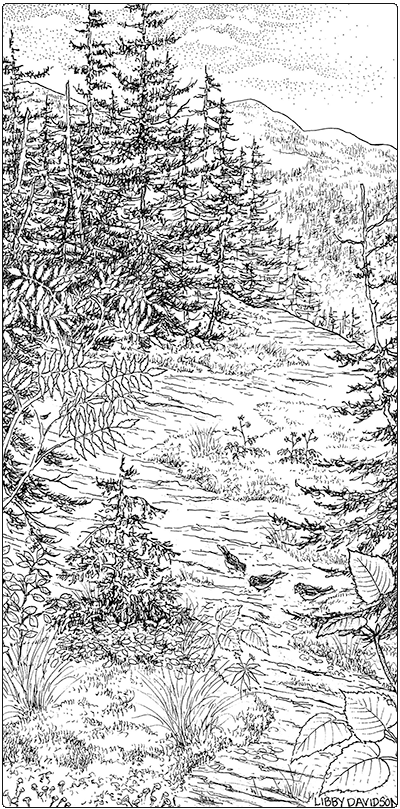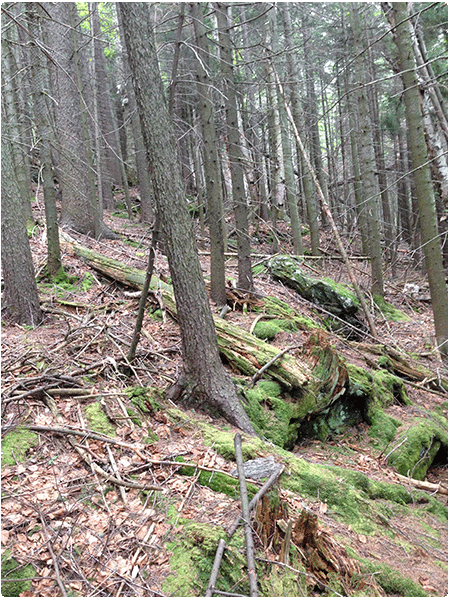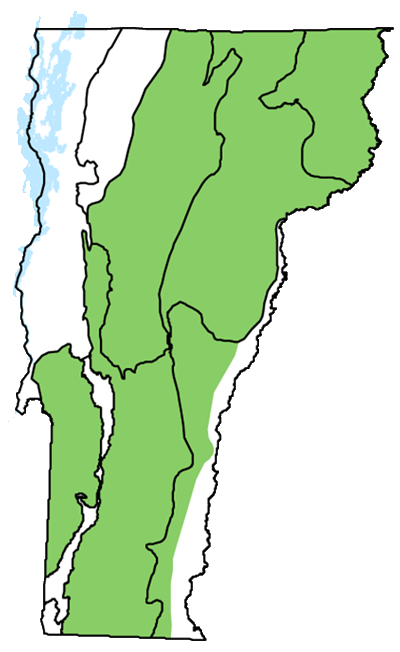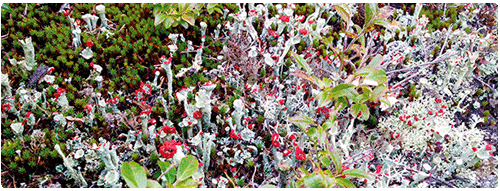Ecology and Physical Setting
Be prepared to hike uphill to visit this community. It occurs on convex slopes, ridgelines, low summits, and exposed ledges, usually over schist, granite, or other acidic bedrock. It is found at elevations from 1,500 feet to 3,200 feet, and rarely up to 3,500 feet. Soils on the slopes, ridgelines, and summits are naturally very shallow and well-drained. Some examples, especially those found on plateaus, developed following large fires that removed the organic soil and exposed the bedrock. Many of these fires were the result of intense logging in the 19th century, and the resulting accumulation of dried slash. One of the largest examples of this community type in Vermont is on a broad ridge above the escarpment of the Southern Green Mountains and is known as “The Burning”, in reference to the intense fires in this area in the 1850s.
The abundance of red spruce, and the relative rarity of fire-tolerant species such as red pine and black huckleberry, however, suggest that fires are not a frequent natural disturbance in this community. Instead, droughty soils and wind are the primary factors that maintain these places.
Vegetation
Dry, nutrient-poor growing conditions in this community result in a low canopy of stunted spruce. This community ranges from dense forest to sparse woodland. In some woodlands, particularly at higher elevations, the trees can be very short, reaching less than 20 feet in height. The canopy is always dominated by red spruce. Less abundant are balsam fir, mountain paper birch, red maple, and American mountain ash. At the lower elevations and in warmer settings, white pine and red oak may be present, though never common. The shrub layer is usually well-developed but can be nearly absent in examples with a dense canopy. Frequent shrub species include lowbush blueberry and velvetleaf blueberry, and sometimes sheep laurel, mountain holly, and wild raisin. Herb cover is typically sparse. Common species include bristly sarsaparilla, hairgrass, and three-toothed cinquefoil. Bryophytes and lichens are often abundant, especially in woodland settings.
Wildlife Habitat
This community supports many breeding songbirds, including yellow-rumped warbler, red-breasted nuthatch, and ruby-crowned kinglet. Red crossbills, white-winged crossbills, and pine siskins are sporadic winter visitors, feeding on spruce cones in years of abundance. Mountain ash berries can be an important food source for bears, as well as for robins and cedar waxwings. In winter, dense softwoods provide cover for species such as ruffed grouse and snowshoe hare.
Successional Trends
Shallow soils and dry growing conditions limit tree growth in this community. Fire does not appear to be a regular disturbance but is responsible for creating the shallow-soil condition under which some examples of the community have developed. At higher elevations and on exposed sites, wind and ice likely play a role in maintaining a stunted woodland structure.
Related Communities
- Montane Spruce-Fir Forest typically has deeper soils, taller trees, and fewer heaths. Montane Spruce-Fir Forest generally occurs from 2,500 to 3,500 feet elevation.
- Subalpine Krummholz Balsam fir and black spruce are typically dominant in this community, which is limited to the very highest elevations (above 3,500 feet). Red Spruce-Heath Rocky Ridges can have stunted trees but they lack the dense, matted horizontal growth that characterizes the “crooked wood” of Subalpine Krummholz.
- Boreal Outcrop shares many species with Red Spruce-Heath Rocky Ridge, but has a canopy cover less than 25 percent. Open patches of Boreal Outcrop are often found intermixed with patches of Red Spruce-Heath Rocky Ridge.
- Dry Red Oak-White Pine Forest shares similar landscape settings, but at lower elevations and in warmer climate areas. Red oak and white pine dominate, though red spruce can be present.
Conservation Status and Management Considerations
This is an uncommon community type in Vermont. Most examples are largely undisturbed by humans, owing to their remote and rugged locations. Potential threats include hiker trampling and the development of communication or wind energy towers.
Distribution/Abundance
Small examples are found scattered in the hilly and mountainous regions of the state, generally at elevations between 1,500 and 3,200 feet. The largest examples in Vermont are in the Green Mountains. This community is found throughout the mountains of northern New England, New York and eastern Canada.
Characteristic Plants
Trees
Abundant Species
Red Spruce – Picea rubens
Occasional to Locally Abundant Species
Balsam fir – Abies balsamea
Paper birch –Betula papyrifera
Heart-leaved paper birch – Betula cordifolia
White pine – Pinus strobus
American mountain ash – Sorbus americana
Red oak – Quercus rubra
Red pine – Pinus resinosa
Shrubs
Abundant Species
Low sweet blueberry – Vaccinium angustifolium
Velvetleaf blueberry – Vaccinium myrtilloides
Occasional to Locally Abundant Species
Sheep laurel – Kalmia angustifolia
Bartram’s shadbush – Amelanchier bartramiana
Mountain holly – Ilex mucronata
Herbs
Occasional to Locally Abundant Species
Three-toothed cinquefoil – Sibbaldia tridentata
Bristly sarsaparilla – Aralia hispida
Hairgrass – Deschampsia flexuosa
Sarsaparilla – Aralia nudicaulis
Bunchberry – Cornus canadensis
Starflower – Lysimachia borealis
Prickly tree clubmoss – Dendrolycopodium dendroideum
Bracken fern – Pteridium aquilinum
Bryophytes and Lichens

in rocky openings within Red Spruce-Heath Rocky Ridges.
Shreber’s moss – Pleurozium schreberi
Moss – Dicranum scoparium
Moss – Polytrichum juniperinum
Pincushion moss – Leucobryum glaucum
Moss – Ptilidium ciliare
Reindeer lichen – Cladonia/Cladina spp.
British soldiers – Cladonia cristatella
Associated Animals
Red squirrel – Tamiasciurus hudsonicus
Snowshoe hare – Lepus americanus
Yellow-rumped warbler – Setophaga coronata
Red-breasted nuthatch – Sitta canadensis
Ruby-crowned kinglet – Regulus calendula
Dark-eyed junco – Junco hyemalis
White-throated sparrow – Zonotrichia albicollis
Ruffed grouse – Bonasa umbellus
Rare and Uncommon Animals
White-winged crossbill – Loxia leucoptera
Red crossbill – Loxia curvirostra
Pine siskin – Spinus pinus
Places to Visit
C.C. Putnam State Forest, Middlesex and Waterbury, Vermont Department of Forests, Parks, and Recreation (VDFPR)
Camel’s Hump State Park, Bolton, Duxbury, and Huntington, VDFPR
The Burning, Lye Brook Wilderness, Sunderland, Green Mountain National Forest (GMNF)
White Rocks National Recreation Area, Wallingford, GMNF
